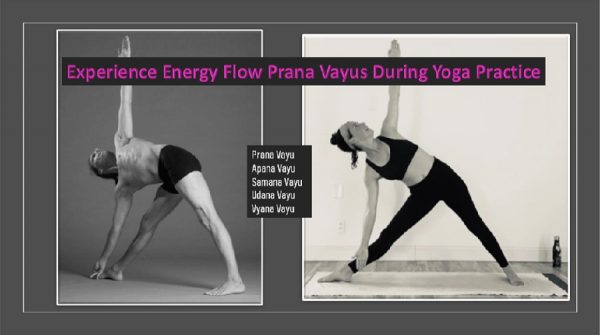
Experience Energy Flow Vayus In Yoga Practice
Have you ever experienced energy flow as you get into a pose in your yoga practice? In yoga, vayu refers to an energetic force that moves in specific direction in our body and influences body function, health and activities. Saints and Yogis in India found 49 distinct types of such energetic movements or vayus in human body. Out of 49 vayus only five Vayus are considered as Pancha (five) prana and are used in yoga practice. These five forces are tools that help us in healing mind, body, and spirit. These distinguished vayus govern specific area of the body and helps in keeping functions of the body in harmony. Any change or subtle movement in Vayus affect our mental and physical health. Any imbalance in any Vayu will have negative impact on associated Chakra and the organs associated with.
Vayus is a Sanskrit word. It means “wind”. The five vital forces of Vayus can be experienced through several yoga poses. These five Vayus that yogis should be aware of are:
Prana Vayu: Situated in the heart, Prana vayu is often considered to be the main energy force flow. It refers to forward moving air that flows inwards and upward. It nourishes eyes and brain. It is the fundamental energy in the body that influences other types of vayus. Any change in Prana vayu or if it turns to be weak, mind cannot think, focus or experiences anxiety, worry, low energy and weak immune system.
To feel prana vayu – close your eyes, sit straight and relax the body as you are into meditation. As you inhale focus on third eye and imagine and feel an energy flowing from belly to torso and reaching third eye. Yoga poses that are heart and chest opening will activate Prana vayu energy. Camel pose, Inverted plank, dancer pose, bridge pose, cobra pose, bow pose – activates and strengthen prana vayu.
Apana Vayu: Situated in the pelvic floor and responsible for the energy in lower abdomen. The air that moves away and flows downwards and out is Apana vayu. The energy from apana vayu influences health of reproductive, digestive and excrete organs. It is also known as elimination energy. Any disturbance in Apana Vayu causes problem in muladhara chakra and creates a feeling of uneasiness, weakness in legs. It affects kidney, intestine and urinary functions.
If one must feel Apana vayu, sit in meditation pose with straight back. Exhale and feel the flow of energy down from head to tailbone to feet. To strengthen the week apana vayu, forward bends and twisted poses helps. Poses that involve leg muscles are good for this purpose. Thrikonasana, warrior 1 and 2, chair pose, extended leg to toe poses, forward bend, childpose, downward dog pose -strengthens apana vayu.
Samana Vayu: Situated in abdomen, the energy originated in navel. It is referred as balancing air, moves from periphery to center of the body. It’s function attributed to assimilation and Manipura chakra (fire). Any imbalance in samana vayu reduces desire, confidence, lack of motivation. Digestive system problem is also attributed to weak samana vayu.
Sit straight, while inhaling and exhaling feel the flow of energy flowing from periphery -on sides, back and front of torso. This gives you the feeling of samana vayu. Core strengthening and twisting poses makes samana vayu flow strong and active.
Udana Vayu: It is situated in throat region and flows circular around head and neck. Udana vayu mean “the air flows upwards” from heart to head and brain. It influences the way we speak, express and think. It is associated with vishuddha chakra. Any subtle movement in udana causes problem in breathing and sickness in throat. Loss of balance as well as lack of self-expression is because of weak udana vayu.
Sit straight and breath deep. Imagine the flow of breath that circulates around your head and neck while focusing on third eye. This eventually gives you the experience of udana vayu flow. Head stand, shoulder stand, circulating head /neck and other inversion poses as well as the back bending poses strengthens the udana vayu flow.
Vyana Vayu: Situated in lungs and heart. The energy flows throughout the body. It is referred as outward moving air, flows from the center of the body towards periphery. It is associated with Svadisthana Chakra (and water element). Any subtle movement in this energy results in poor blood circulation, nerve weakness, skin problem and feeling of loneliness, separation.
While sitting or standing stright, imagine the flow of energy from your navel towards both legs and arms. The feeling of energy flow in this way is vyana vayu. Sun salutations and warrior poses, that makes you aware of your entire body through blood circulation will help strengthen the vyana vayu.
Experiencing all five vayus during yoga practice will give us more calming experience. For example, to experience all five vayus try triangle or trikonasana. Apart from stretching the legs and arms while you are in trikonasana, if you focus on energy flow you will notice all five vayus inside your body. While you are into the triangle pose, feel the flow of energy move down legs and reaching feet – it is Apana vayu. While you breath and expand lungs, it is prana vayu flow. As you elongate and straighten the spine from neck to tail – it is udana vayu. The bit of twisting and looking up gives you the feel of samana vayu. The extension of arms in both directions and stretch of legs will give you vyana vayu!
In your next yoga practice focus on prana vayus and feel the energy flow. Awakening the prana vayus during yoga practice gives us more benefit than we think!
References:
- https://www.theyogasanctuary.biz/vyana-vayu/
- http://total-yoga.org/vyana-vayu/
- https://www.yogajournal.com/
- Image credit: Yoga asanas from Karnataka yoga- Booklet
Author: Sumana Rao | Posted on: May 9, 2021
« Divine & Disciplined: Yoga and Bharathanatyam The Good and Bad Anger »






















Write a comment